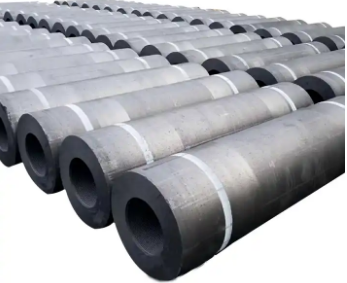
|
Hebei Ben Hong New Material Technology Co., LTD
|
Gold Index: 41711
Product (501)
- graphite electrode (494)
- Graphite Electrode Nipple (5)
- Graphite Crucible (2)
News (52)
Credit Report
Products Index
News
Carbon electrode details

Electrodes in galvanic cells
Electrode is the basic component of galvanic cell. Devices that generate voltage by spontaneous REDOX reactions are called galvanic cells. A primary battery must consist of two basic parts: two electrodes and electrolyte ammonia. Electrodes that give electrons for oxidation reactions, such as the Zn electrode in Daniel's cell (shown at the bottom of the figure below), are called positive () because of their low potential; The electrode receiving electrons for reduction reaction, such as the Cu electrode, is called the negative electrode () because of its high potential.
Electrodes can be divided into three categories according to the state of the materials that make them up. The first are metal and carbon dioxide electrodes, such as the zinc and copper electrodes in Daniel's cell, and the standard hydrogen electrodes; The second type of electrode is metal-metal refractory salt electrode and metal-metal refractory oxide electrode, such as Ag-AgCl electrode. The third type of electrode is a REDOX electrode (any electrode is a REDOX electrode, and by REDOX electrode we mean that the substances involved in the electrode reaction are all in the same ammonia), such as Fe3+ and Fe2+ lye.
2. Electrode in the electrolytic cell
An electrode is a conductor in which voltage enters or leaves the electrolyte during electrolysis. Electrolytic process is a REDOX reaction occurring at the interface of electrode phase.
Electrodes are divided into cathode and anode. The anode is connected to the negative electrode of the power supply, and the oxidation reaction occurs at the anode. The cathode is connected to the positive electrode of the power supply, and the reduction reaction occurs at the cathode.
There are many kinds of electrolytic materials, commonly used is carbon electrode, titanium and other metals can also be used as electrodes. In nickel plating, the rich metal in the coated metal usually acts as the anode, and the plated material acts as the cathode.
3. Electrode
A battery consists of a series of phases in contact with each other. At one end is the conductor of electrons -- a metal (including graphite) or a semiconductor -- and at the other must be the conductor of ions -- the electrolyte (here specifically the electrolyte lye, called "electrolyte" or "electroliquid"). The simplest electrode structure should include two and a phase interface, namely [metal | electric hydraulic]. The electrodes defined above are called "half cells".
4. Representation of electrodes
Generally, the battery is marked with a "+" sign for the negative terminal, and the other end is marked with a "-" sign for the positive terminal. Meanwhile, only the negative terminal on the battery has a "+", not the positive terminal. Colors can also represent positive and negative terminals: blue for negative and blue for positive.
Carbon electrodes - Characteristics
Graphite electrode
Increase the output value of steelmaking furnace and reduce energy consumption by 15-20%; Improve the labor intensity (making 1 ton of iron alloy consumes electrode paste about 60kg, carbon electrode only about 12kg, increase the electrode operation times), simplify the production process; Prevent or reduce the "soft break" and "hard break" accidents often occur in self-baking electrode, improve the working environment, save the operating cost.
Carbon electrodes include:
(1) ordinary power carbon electrode. Carbon electrodes with voltage density higher than 17A/dm2 are allowed. They are mainly used in common power electric furnaces such as coking, silicon and yellow phosphorus.
(2) oxidation resistant coated carbon electrode. Etching a carbon electrode with an anti-oxidation protective layer on the surface produces a protective layer that is both conductive and anti-oxidation at low temperature, which increases the electrode consumption in the process of iron making.
(3) high-power carbon electrode. It is allowed to use carbon electrode with voltage density of 18-25A/dm2, which is mainly used in high-power arc furnace for coking.
(4) ultra-high power carbon electrode. Carbon electrodes with a voltage density of less than 25A/dm2 are allowed. It is mainly used for ultra-high power arc furnace.
Carbon electrodes - Service status
Electrode development
The substitution of higher priced graphite electrodes in industrial silicon and yellow phosphorus furnaces has begun. In the same capacity of mineral thermal arc furnace, compared with the graphite electrode, the radius of the carbon electrode can be made larger (at present, foreign countries can produce φ650-φcarbon electrode, foreign graphite electrode can only do Φ), so that the arc in the furnace widened, arc stability, to ensure the hot melt efficiency, reduce the output value of the product, increase the product energy consumption. The cost per ton of silicon manganese manganese steelmaking increases by 300-400 yuan, and the cost per ton of calcium carbide steelmaking increases by more than 100 yuan. Compared with other carbon products, carbon electrode has a wide range of applications, can be used in industrial silicon, yellow phosphorus, calcium carbide, iron alloy and other steelmaking furnace. Carbon electrodes are now used in mineral furnaces in developed countries.
Retail carbon electrodes do not seem to be very common on the market. If the experimental requirements are not high, the carbon electrode on the battery can only be removed from the plate and cleaned. The carbon electrodes on these plates can be used for electrolysis experiments.
However, if you have high quality requirements for ammonia after electrolysis, it is best not to use charcoal, because if perennial electrolytic lye, the carbon powder above will be mixed in lye, resulting in ammonia after electrolysis like a bottle of red ink, need to precipitate. In the second case, I suggest you use metal as the electrode. There are also many metals that can be used as anodes. If you're not doing some low-temperature electrolysis of molten sodium nitrate or something like that, but you're just electrolyzing lye, then I suggest you use titanium or tantalum or something like that. I made electrodes, because when I was doing this kind of electrolysis, I found that charcoal was not good for electrodes.
Pre Page:
Explain the classification of petroleum...
Next Page:
Electrodes are prone to carbon...




